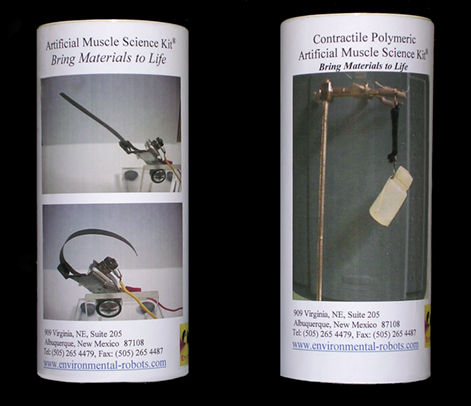Artificial Muscle Kits for the Classroom
Originating Technology/ NASA Contribution
Commonly referred to as “artificial muscles,” electroactive polymer (EAP) materials are lightweight strips of highly flexible plastic that bend or stretch when subjected to electric voltage. EAP materials may prove to be a substitution for conventional actuation components such as motors and gears. Since the materials behave similarly to biological muscles, this emerging technology has the potential to develop improved prosthetics and biologically-inspired robots, and may even one day replace damaged human muscles. The practical application of artificial muscles provides a challenge, however, since the material requires improved effectiveness and durability before it can fulfill its potential.
Partnership
In 2000, NASA’s Johnson Space Center granted Environmental Robots, Inc. (ERI), of Albuquerque, New Mexico, a Phase II Small Business Innovation Research (SBIR) contract to develop a family of artificial muscle systems with robotic sensing and actuation capabilities for a wide spectrum of NASA space robotic and extravehicular activity (EVA) applications. As a result, the company developed two types of ionic polymeric artificial muscles: a bending, flexing, deforming type with sensing and actuation capabilities, and a fibrous electrochemical contractile type that is comparable to mammalian muscles.
Product Outcome
In order to bring artificial muscle technology to the attention of researchers, scientists, and engineers, as well as high school and college students, ERI began working on two educational outreach products as part of a Phase III SBIR contract with NASA Johnson. The company developed the Artificial Muscles Science Kit® and the Contractile Polymeric Artificial Muscles Science Kit® after designing a simple procedure to manufacture two electrically controllable strips of polymeric artificial muscle and package them in a safe, low-cost kit.
The first kit focuses on the bending and flexing polymers with ionic polymer metal composites, while the second kit explores chemically or electrochemically activated polymers in the form of contractile fiber bundles. Both kits provide users with the basic materials and items necessary to safely create artificial muscles and test them for actuation and sensing. Materials in the kit include pre-treated ionic polymer strips, Chemical Material Data Safety Sheets, protective gloves, electrical wires, self-adhesive copper tape, and a pre-fabricated artificial muscle as a reference sample. The kits also contain detailed instructions and technical documents pertaining to all of the artificial muscle samples.
As part of its SBIR work, ERI also commercialized a biometric sensor and actuator element with attached electrodes, as well as an assortment of contractile and bending ionic polymeric artificial muscles. While ERI’s science kits aim to promote the science and technology of artificial muscles, these other products have possible applications for NASA’s space robotics, autonomous EVA actuation and sensing capabilities, and space robotic automation. The technology may also benefit nanosensing and nanoactuation applications.
Artificial Muscles Science Kit® and Contractile Polymeric Artificial Muscles Science Kit® are registered trademarks of Environmental Robots, Inc.

The two science kits contain the basic materials needed to safely create artificial muscles and test them for actuation and sensing.













